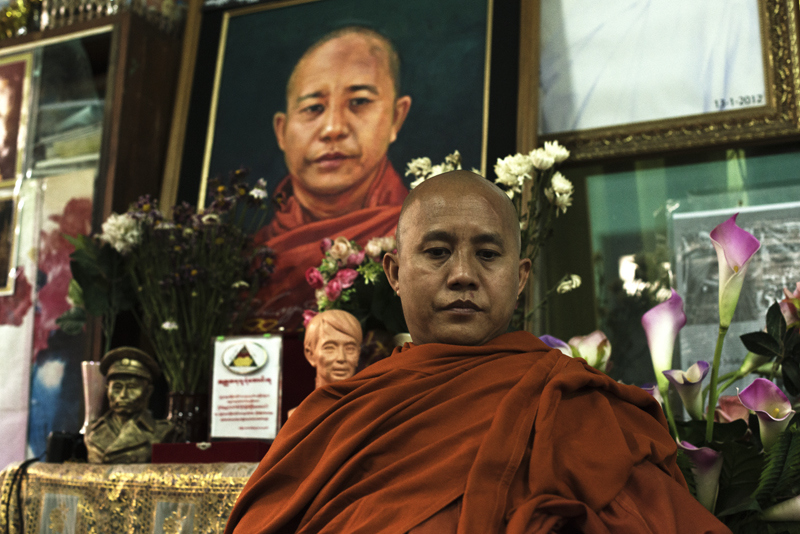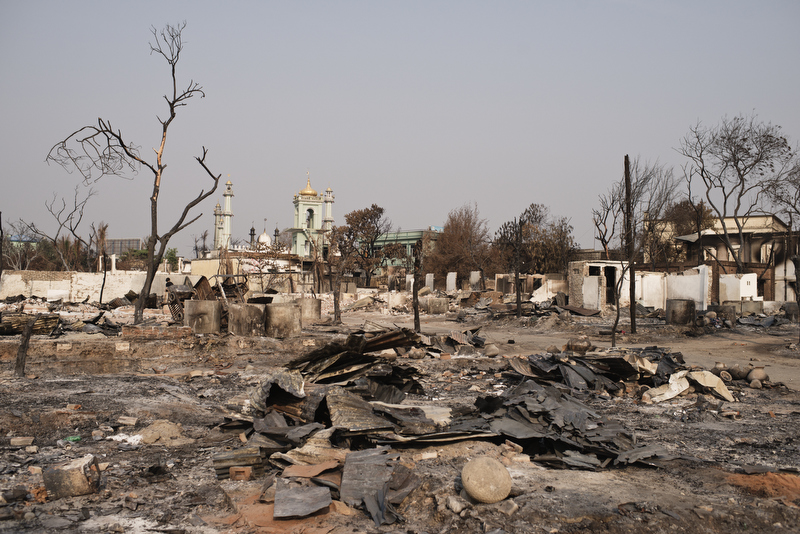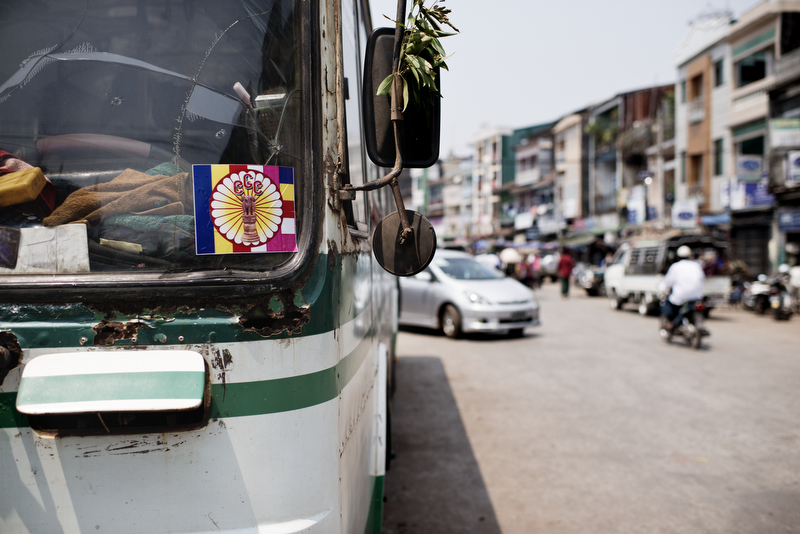
The monk Ashin Wirathu, famous for his inflammatory anti-Muslim speeches, at the Masoeyein Monastery in Mandalay. Photo © Vincenzo Floramo.
By Francis Wade
Down a leafy backstreet in Mandalay sits the nerve centre of Burma’s budding and violent anti-Muslim movement. Its leader, poised and resplendent in a saffron robe, hands over leaflets detailing the threat posed by Islam in Burma, while the meditative sound of dharma chanting floats through the buildings.
It’s a confusing picture: U Wirathu, the leader of a campaign that vilifies the country’s Muslim community, and whose adherents have forced tens of thousands into refugee camps, is one of Burma’s more prominent monks, and the Masoeyein monastery that he heads was once a key organizing hub for anti-government activities. For those who considered Buddhism an unflinching source of peace, U Wirathu is a sobering corrective.
“According to my research, 100 percent of rape cases in Burma are by Muslims; none are by Buddhists,” he told me during an interview at the monastery in April; Comments like that have fueled several waves of violence against Muslims, the latest occurring in March in the central Burmese town of Meiktila. A fight in a gold shop in late March between a Buddhist couple and the Muslim shop owner was followed by the killing of a monk by a Muslim mob. The town then descended into chaos, with two days of unrest leaving the official death toll at an estimated 40 people, with 12,000 displaced – they add to the 125,000 Rohingya Muslims who were driven from their homes in Arakan state during rioting last year. Like the Arakan state capital of Sittwe, entire Muslim quarters in Meiktila were razed to the ground. Now residing in camps, the expulsion of Meiktila’s Muslim population has leant weight to fears voiced in a recent Human Rights Watch report that ethnic cleansing is underway in Burma.
U Wirathu boasts responsibility for the resurgence of anti-Muslim sentiment in Burma, which has a long history dating back to the early days of independence in 1948. The departure of the British and upsurge in post-colonial nationalist sentiment amplified animosity towards Indians, hundreds of thousands of whom had been brought to Burma by the British to work as laborers or in administrative positions. Many of these were Muslim, and the hostility was exploited by then prime minister U Nu, who expelled the Burma Muslim Congress. General Ne Win, the country’s first dictator who took power from U Nu in a coup in 1962, then banned Muslims from taking up government positions.
Wirathu has overseen the production of a steady stream of propaganda: illustrations of Muslims, depicted as nightmarish lions, attacking young Buddhists; sermons, circulated via DVDs in their thousands, describing the beginnings of a conspiracy in 1942, when Rohingya fought alongside the British against the Japanese, to Islamicise swaths of Burma with the support of international Muslim groups. Last year he led a protest of hundreds of monks in support of President Thein Sein’s request that the UN resettle the entire 800,000-strong Rohingya population; more recently he has ordered an effective boycott of all Muslims, advocating a ban on them marrying and trading with Buddhists.
He does not match the image of Burma’s monastic community that was sculpted in the wake of the 2007 uprising, when thousands of monks joined peaceful protests against military rule that were met with the heavy hand of the army. Dozens of monks were killed, yet their stoicism in the face of brute force only added to their global hero status. Wirathu however didn’t join them: he was in jail at the time, having been sentenced in 2003 on charges of inciting religious violence—he was freed during an amnesty in 2010. Not surprisingly, his target was Burma’s Muslims.

Barricades manned by Muslim residents at Mingalar Taungnyunt quarter, in Yangon. Photo © Vincenzo Floramo.
Wirathu’s approach to religious purity harks back to 11th century Burma, when King Anawrahta set about entrenching Theravada Buddhism as the religion of the Bamar and built hundreds of temples and pagodas. Buddhism became the ultimate glue for a Burmese society faced with increasing influxes of Kachin, Mon and Indian. Monastic teachings would preserve Buddhism, and monks became de facto agents of social control who instructed the youth to revere Burma’s monarchs. As time went by, exposure to Buddhism meant other ethnicities, like the Shan, adopted the Theravada brand, and Shan kings gained popular support by expanding the number of temples.
That conflation of religion with power leant itself to a form of religious nationalism that has continued over centuries, with monks at the vanguard of the movement beginning in the 1920s to end British rule. Today, extremist advocates have drawn on it to justify the current anti-Muslim campaign, promulgating the global demonization of Muslims in the wake of 9/11 and fear-mongering about Islam’s doctrine of aggressive proselytization. However, its principal crux remains steadfast: that to be truly Burmese, one must be Buddhist. Persecution of Christian minorities in the north and east has in turn added to the sense that the government is seeking to rid Burma of non-Buddhists and unite the country under one flag.
The broader nationalist ethos had once been popular among Burma’s monks. “I used to be influenced by anti-Muslim ideologies,” U Gambira, a former monk who was jailed for his key role in the 2007 uprising, told me one afternoon in late March in Meiktila. Next door to the house where we met was a monastery that hosted Wirathu in December last year. Since then, stickers bearing the numbers 969 have appeared all over the town. The numbers signify the nine attributes of Buddha, the six attributes of his teachings, and the nine attributes of the Sangha, the religious council that administers Buddhist institutions in Burma; and they have come to represent the anti-Muslim movement. “Later, however, I began to understand, through conversations with my father and Buddhist studies I was taking, that the anti-Muslim sentiment was wrong and I abandoned it,” Gambira said. Although now disrobed and banned from entering monasteries, he has been one of the few prominent voices to speak out against the part played by monks in the movement and their active role in the violence against Muslims.
Yet it is Wirathu who continues to attract all the attention. Monk followers traipse round the busy market in Mandalay handing out DVDs of his sermons and 969 stickers accompanied by a list of instructions about how to preserve Buddhism. His potential reach is vast. Yet for Wirathu, the ramifications of the hate speech he delivers to his followers are lost. “If the monks [who attacked Muslims in Meiktila] listened to my speeches, there would be no violence,” he says. Elsewhere in the interview, however, he counters this with comments that could well direct anger towards Muslims. ““Every day in Rakhine state Muslims enter houses and kill Buddhists. They don’t even do it to steal things – they just want to kill them.” He opts to be interviewed in his monastery in front of a wall filled with self-portraits; men nearby film and photograph me throughout the interview. He will later post these on his Facebook page – I sense that he believes journalists come here to learn from him, and bask in his spiritual purity. “If everyone in Burma was like me there would be peace,” he continues.
Upon leaving the monastery, my translator – a young teacher at a nearby school who had completed a university degree in law – delivered a shock. “It’s amazing how much information he has about Muslims; it’s very impressive,” she said. Two days after the interview, I received a text message from the man who had introduced me to Wirathu, and who during the ride to the monastery had spoken of his frustration at the monk’s hate speech. He had also u-turned. “I watched Wirathu CD. I feel very angry – they take our air, water, land; they make terrorism,” he wrote.
Wirathu’s ability to attract supporters through such crass and unsubstantiated statements has much to do with his status as a monk. How could someone of such spiritual authority possibly be wrong, especially in the eyes of a Burmese public who have been taught for centuries to consider Buddhism as the highest moral plane?
It is also worth examining the shift in the direction of the Sangha since military rule began. Under General Ne Win’s rule, monks who didn’t share the regime’s vision of Burma were disrobed, and ultranationalist monks elevated to senior positions within the Sangha they could help justify the conditions of Burma under military rule as necessary for the survival of Buddhism against so-called destructive elements: rebellious ethnic groups, foreign powers and the spread of other religions.
As time went on and Burma spiraled into civil war and economic misery, many young Burmese joined monkhood to escape poverty and conflict. This effectively resulted in a sizeable chunk of the monastic order having donned the robes through force and necessity, and not necessarily for the purpose of religious observance. Signs of the corruption of the monastic order continue to emerge. In February last year, Gambira was arrested again for attempting to break into the monastery from which he had been ousted after his imprisonment in 2007. Police took him to a pagoda in Rangoon, where he was met by members of the Maha Nayaka Sangha Council. The monks of Maha Nayaka, formed by the state in 1980 and placed under control of the religious affairs ministry, had already closely aligned themselves with the military generals. The next day the state-run New Light of Myanmar reported that the Council had urged the government to take legal action against Gambira.
The combination of politics, religion and nationalism in Burma together with effective propaganda campaigns had a combustive effect in Arakan state last year when anti-Rohingya sentiment gained mass support among Burmese at home and abroad, many of whom had likely never come into contact with anyone from the Rohingya community. It was the consistent dehumanizing of the Rohingya in the eyes of Burmese that whipped up such ugly vehemence. This was reinforced by the government’s refusal to afford them basic human rights, which only amplified their pathetic situation and further cast them as the ‘unwanted’. For the Muslims of Meiktila, however, their foe is a man of respect who preaches a twisted version of peace, the path to which must be cleared of non-Buddhist obstacles. Not limited to Meiktila and Arakan state, more recent waves of anti-Muslim violence have occurred in Oakkan, 60 miles from Rangoon, and as far north as Hpakant in Kachin state.
Meiktila is now a no-go area for Muslims. Large neighborhoods in which people of both faiths once lived peacefully now resemble war zones, mostly devoid of life. Stray dogs pick around the rubble, and as I walk past flattened buildings, groups of men appear in the street and make it clear that visitors are not wanted.
Former inhabitants struggle in displacement camps, mostly in school buildings or on university campuses. In one unofficial location for Muslims outside of Meiktila, queues for the daily communal lunch – one sitting for 3,400 people – snake their way around the camp. The local students will return from holidays at the end of May, meaning the camp’s inhabitants will need to leave. With no visible sign that any reconstruction of the razed quarters is underway, let alone attempts to reunite the now-divided communities, the safety of the refugees beyond May remains in jeopardy.
Francis Wade is a Thailand-based journalist. He has been covering Burma and Asia-Pacific since 2009. His work has appeared in The Guardian, Al Jazeera English, Asia Times Online, New Internationalist and elsewhere.
Vincenzo Floramo is a freelance photographer, currently based in Thailand and Burma. His work has appeared in The Guardian, The Bangkok Post, Witness Journal, Life Force Magazine, Der Spiegel, Irrawaddy, and Io Donna.
With support from the Henry R. Luce Initiative on Religion and International Affairs.




